Analyzing Gender and Sexuality: Theories & Media Impact on Experiences
VerifiedAdded on 2023/06/14
|12
|4028
|142
Essay
AI Summary
This essay delves into the complexities of gender and sexuality, examining how these concepts are shaped by social norms, power structures, and media influence. It explores theoretical perspectives such as Marxist feminism and black feminism to understand everyday experiences of gender and sexuality across different countries. The essay highlights the role of media, including newspapers, online platforms, documentaries, and radio broadcasts, in shaping perceptions and influencing social standards related to gender and sexuality. It also addresses the importance of gender equality and the challenges faced by women and girls in accessing education and economic opportunities, ultimately advocating for a more just and equitable society for all genders.

Gender and sexuality.
Paraphrase This Document
Need a fresh take? Get an instant paraphrase of this document with our AI Paraphraser
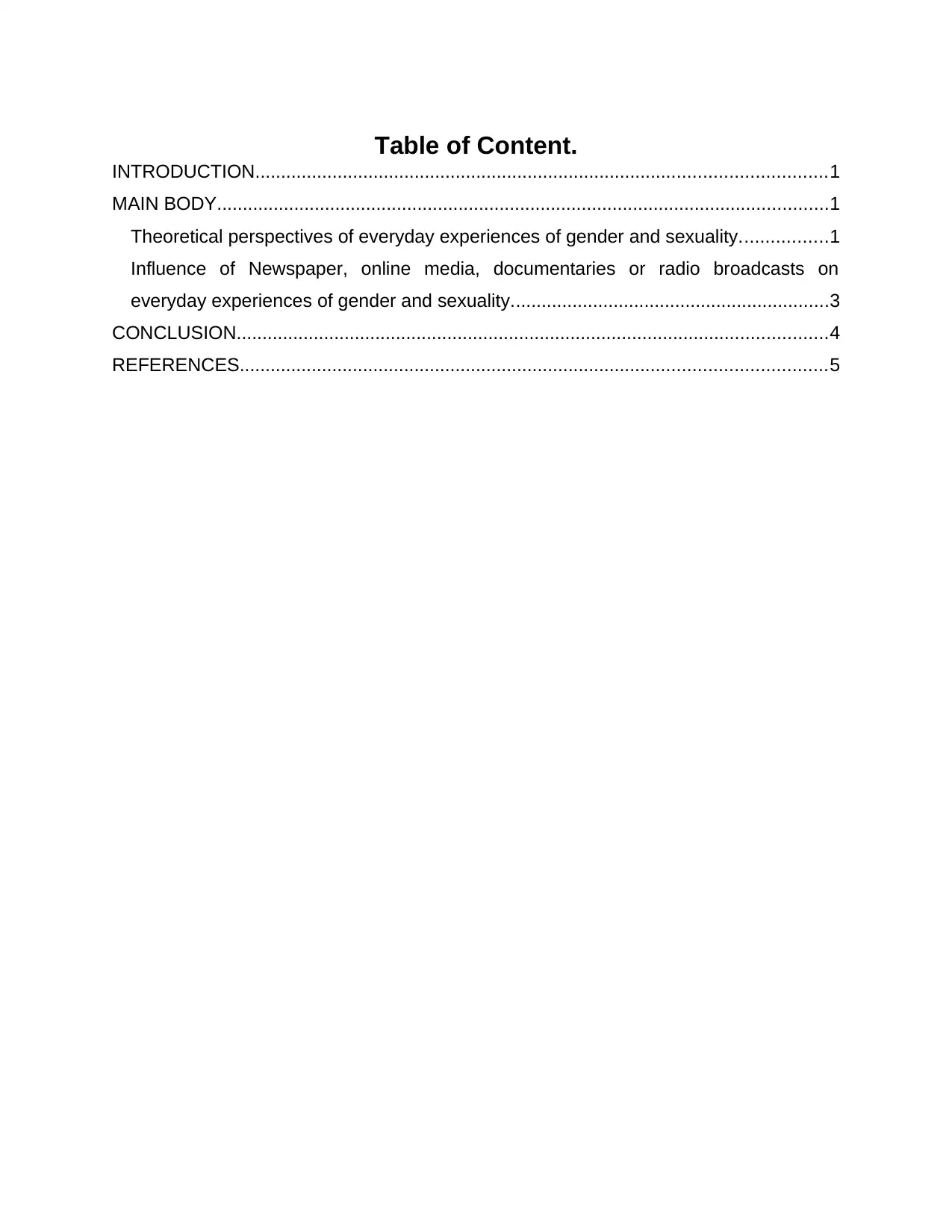
Table of Content.
INTRODUCTION...............................................................................................................1
MAIN BODY.......................................................................................................................1
Theoretical perspectives of everyday experiences of gender and sexuality.................1
Influence of Newspaper, online media, documentaries or radio broadcasts on
everyday experiences of gender and sexuality..............................................................3
CONCLUSION...................................................................................................................4
REFERENCES..................................................................................................................5
INTRODUCTION...............................................................................................................1
MAIN BODY.......................................................................................................................1
Theoretical perspectives of everyday experiences of gender and sexuality.................1
Influence of Newspaper, online media, documentaries or radio broadcasts on
everyday experiences of gender and sexuality..............................................................3
CONCLUSION...................................................................................................................4
REFERENCES..................................................................................................................5
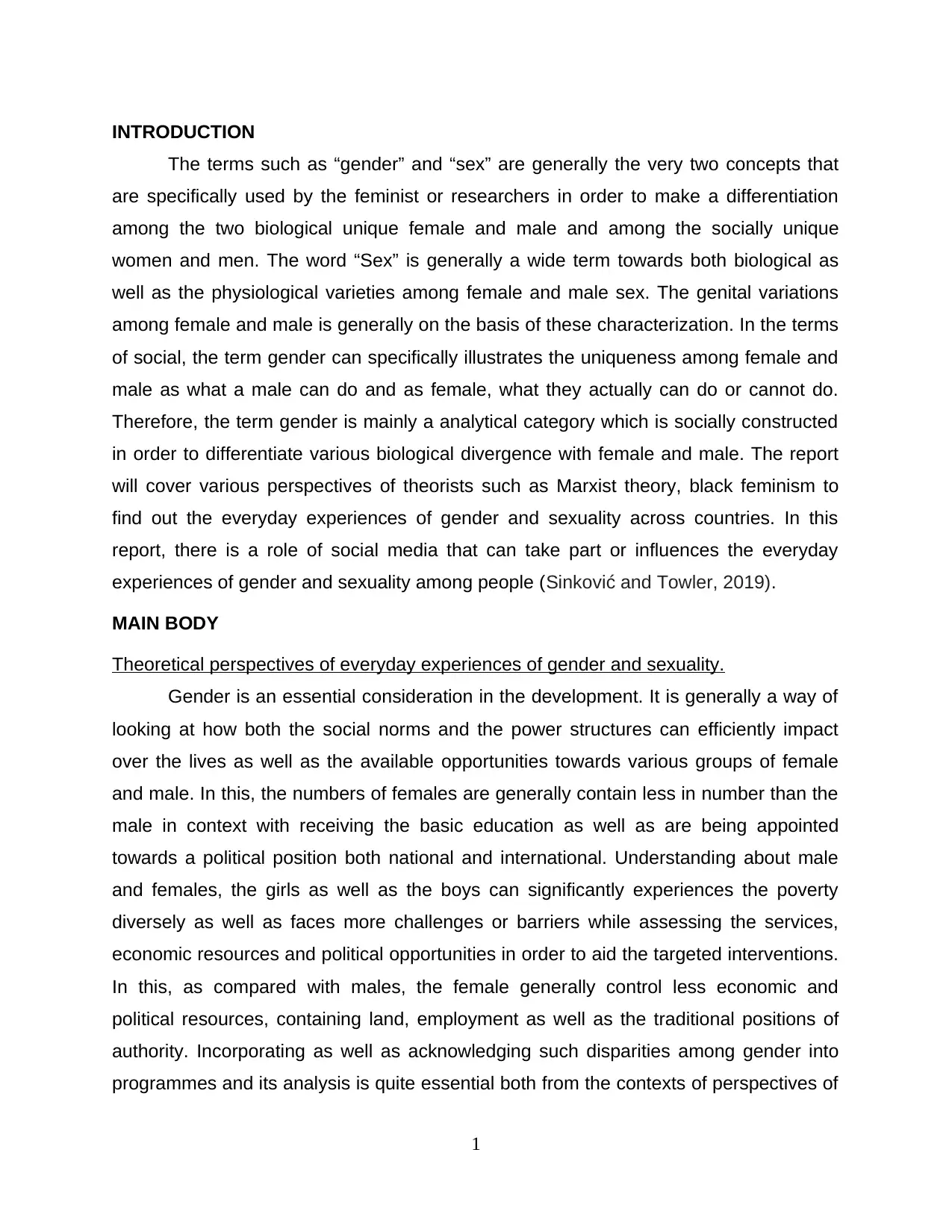
INTRODUCTION
The terms such as “gender” and “sex” are generally the very two concepts that
are specifically used by the feminist or researchers in order to make a differentiation
among the two biological unique female and male and among the socially unique
women and men. The word “Sex” is generally a wide term towards both biological as
well as the physiological varieties among female and male sex. The genital variations
among female and male is generally on the basis of these characterization. In the terms
of social, the term gender can specifically illustrates the uniqueness among female and
male as what a male can do and as female, what they actually can do or cannot do.
Therefore, the term gender is mainly a analytical category which is socially constructed
in order to differentiate various biological divergence with female and male. The report
will cover various perspectives of theorists such as Marxist theory, black feminism to
find out the everyday experiences of gender and sexuality across countries. In this
report, there is a role of social media that can take part or influences the everyday
experiences of gender and sexuality among people (Sinković and Towler, 2019).
MAIN BODY
Theoretical perspectives of everyday experiences of gender and sexuality.
Gender is an essential consideration in the development. It is generally a way of
looking at how both the social norms and the power structures can efficiently impact
over the lives as well as the available opportunities towards various groups of female
and male. In this, the numbers of females are generally contain less in number than the
male in context with receiving the basic education as well as are being appointed
towards a political position both national and international. Understanding about male
and females, the girls as well as the boys can significantly experiences the poverty
diversely as well as faces more challenges or barriers while assessing the services,
economic resources and political opportunities in order to aid the targeted interventions.
In this, as compared with males, the female generally control less economic and
political resources, containing land, employment as well as the traditional positions of
authority. Incorporating as well as acknowledging such disparities among gender into
programmes and its analysis is quite essential both from the contexts of perspectives of
1
The terms such as “gender” and “sex” are generally the very two concepts that
are specifically used by the feminist or researchers in order to make a differentiation
among the two biological unique female and male and among the socially unique
women and men. The word “Sex” is generally a wide term towards both biological as
well as the physiological varieties among female and male sex. The genital variations
among female and male is generally on the basis of these characterization. In the terms
of social, the term gender can specifically illustrates the uniqueness among female and
male as what a male can do and as female, what they actually can do or cannot do.
Therefore, the term gender is mainly a analytical category which is socially constructed
in order to differentiate various biological divergence with female and male. The report
will cover various perspectives of theorists such as Marxist theory, black feminism to
find out the everyday experiences of gender and sexuality across countries. In this
report, there is a role of social media that can take part or influences the everyday
experiences of gender and sexuality among people (Sinković and Towler, 2019).
MAIN BODY
Theoretical perspectives of everyday experiences of gender and sexuality.
Gender is an essential consideration in the development. It is generally a way of
looking at how both the social norms and the power structures can efficiently impact
over the lives as well as the available opportunities towards various groups of female
and male. In this, the numbers of females are generally contain less in number than the
male in context with receiving the basic education as well as are being appointed
towards a political position both national and international. Understanding about male
and females, the girls as well as the boys can significantly experiences the poverty
diversely as well as faces more challenges or barriers while assessing the services,
economic resources and political opportunities in order to aid the targeted interventions.
In this, as compared with males, the female generally control less economic and
political resources, containing land, employment as well as the traditional positions of
authority. Incorporating as well as acknowledging such disparities among gender into
programmes and its analysis is quite essential both from the contexts of perspectives of
1
⊘ This is a preview!⊘
Do you want full access?
Subscribe today to unlock all pages.

Trusted by 1+ million students worldwide
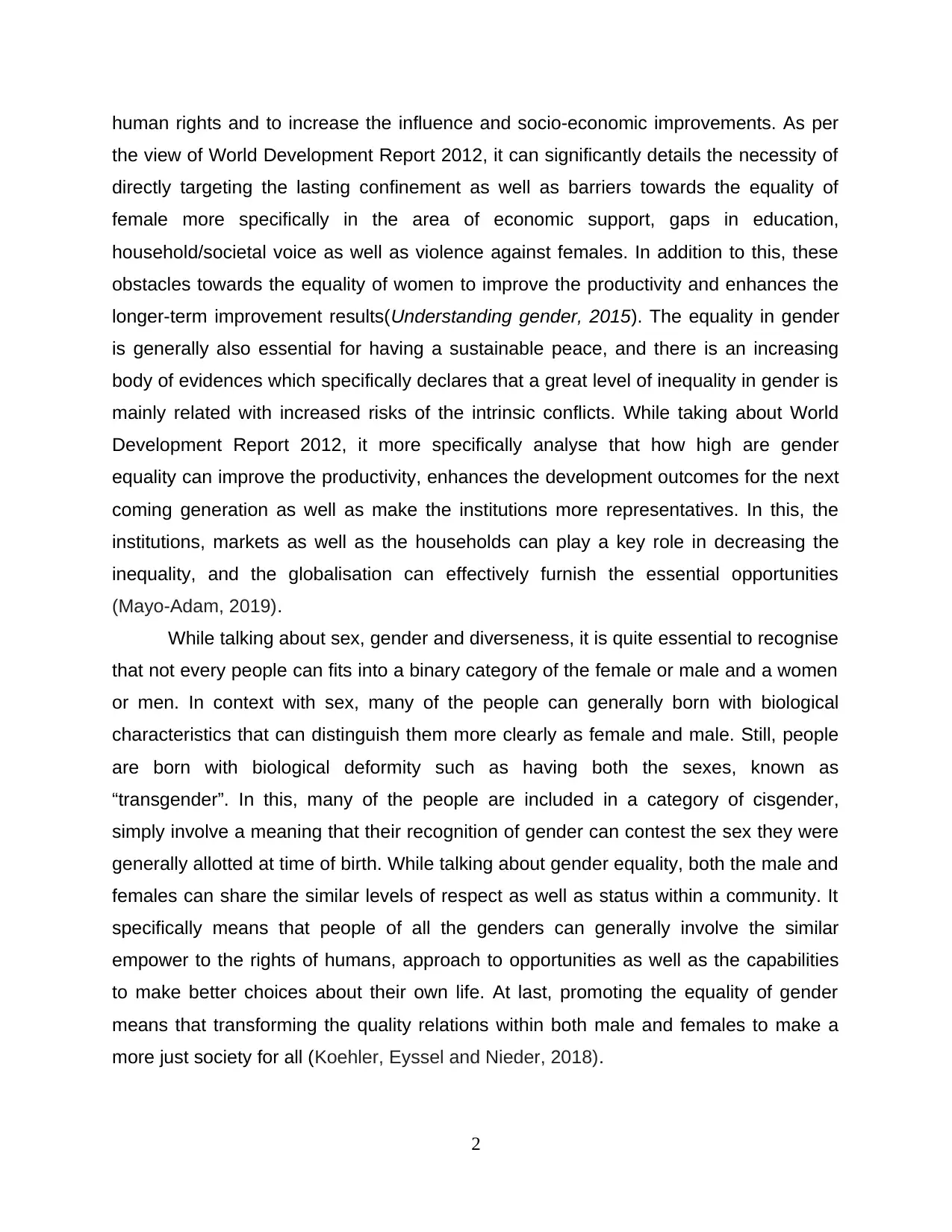
human rights and to increase the influence and socio-economic improvements. As per
the view of World Development Report 2012, it can significantly details the necessity of
directly targeting the lasting confinement as well as barriers towards the equality of
female more specifically in the area of economic support, gaps in education,
household/societal voice as well as violence against females. In addition to this, these
obstacles towards the equality of women to improve the productivity and enhances the
longer-term improvement results(Understanding gender, 2015). The equality in gender
is generally also essential for having a sustainable peace, and there is an increasing
body of evidences which specifically declares that a great level of inequality in gender is
mainly related with increased risks of the intrinsic conflicts. While taking about World
Development Report 2012, it more specifically analyse that how high are gender
equality can improve the productivity, enhances the development outcomes for the next
coming generation as well as make the institutions more representatives. In this, the
institutions, markets as well as the households can play a key role in decreasing the
inequality, and the globalisation can effectively furnish the essential opportunities
(Mayo-Adam, 2019).
While talking about sex, gender and diverseness, it is quite essential to recognise
that not every people can fits into a binary category of the female or male and a women
or men. In context with sex, many of the people can generally born with biological
characteristics that can distinguish them more clearly as female and male. Still, people
are born with biological deformity such as having both the sexes, known as
“transgender”. In this, many of the people are included in a category of cisgender,
simply involve a meaning that their recognition of gender can contest the sex they were
generally allotted at time of birth. While talking about gender equality, both the male and
females can share the similar levels of respect as well as status within a community. It
specifically means that people of all the genders can generally involve the similar
empower to the rights of humans, approach to opportunities as well as the capabilities
to make better choices about their own life. At last, promoting the equality of gender
means that transforming the quality relations within both male and females to make a
more just society for all (Koehler, Eyssel and Nieder, 2018).
2
the view of World Development Report 2012, it can significantly details the necessity of
directly targeting the lasting confinement as well as barriers towards the equality of
female more specifically in the area of economic support, gaps in education,
household/societal voice as well as violence against females. In addition to this, these
obstacles towards the equality of women to improve the productivity and enhances the
longer-term improvement results(Understanding gender, 2015). The equality in gender
is generally also essential for having a sustainable peace, and there is an increasing
body of evidences which specifically declares that a great level of inequality in gender is
mainly related with increased risks of the intrinsic conflicts. While taking about World
Development Report 2012, it more specifically analyse that how high are gender
equality can improve the productivity, enhances the development outcomes for the next
coming generation as well as make the institutions more representatives. In this, the
institutions, markets as well as the households can play a key role in decreasing the
inequality, and the globalisation can effectively furnish the essential opportunities
(Mayo-Adam, 2019).
While talking about sex, gender and diverseness, it is quite essential to recognise
that not every people can fits into a binary category of the female or male and a women
or men. In context with sex, many of the people can generally born with biological
characteristics that can distinguish them more clearly as female and male. Still, people
are born with biological deformity such as having both the sexes, known as
“transgender”. In this, many of the people are included in a category of cisgender,
simply involve a meaning that their recognition of gender can contest the sex they were
generally allotted at time of birth. While talking about gender equality, both the male and
females can share the similar levels of respect as well as status within a community. It
specifically means that people of all the genders can generally involve the similar
empower to the rights of humans, approach to opportunities as well as the capabilities
to make better choices about their own life. At last, promoting the equality of gender
means that transforming the quality relations within both male and females to make a
more just society for all (Koehler, Eyssel and Nieder, 2018).
2
Paraphrase This Document
Need a fresh take? Get an instant paraphrase of this document with our AI Paraphraser
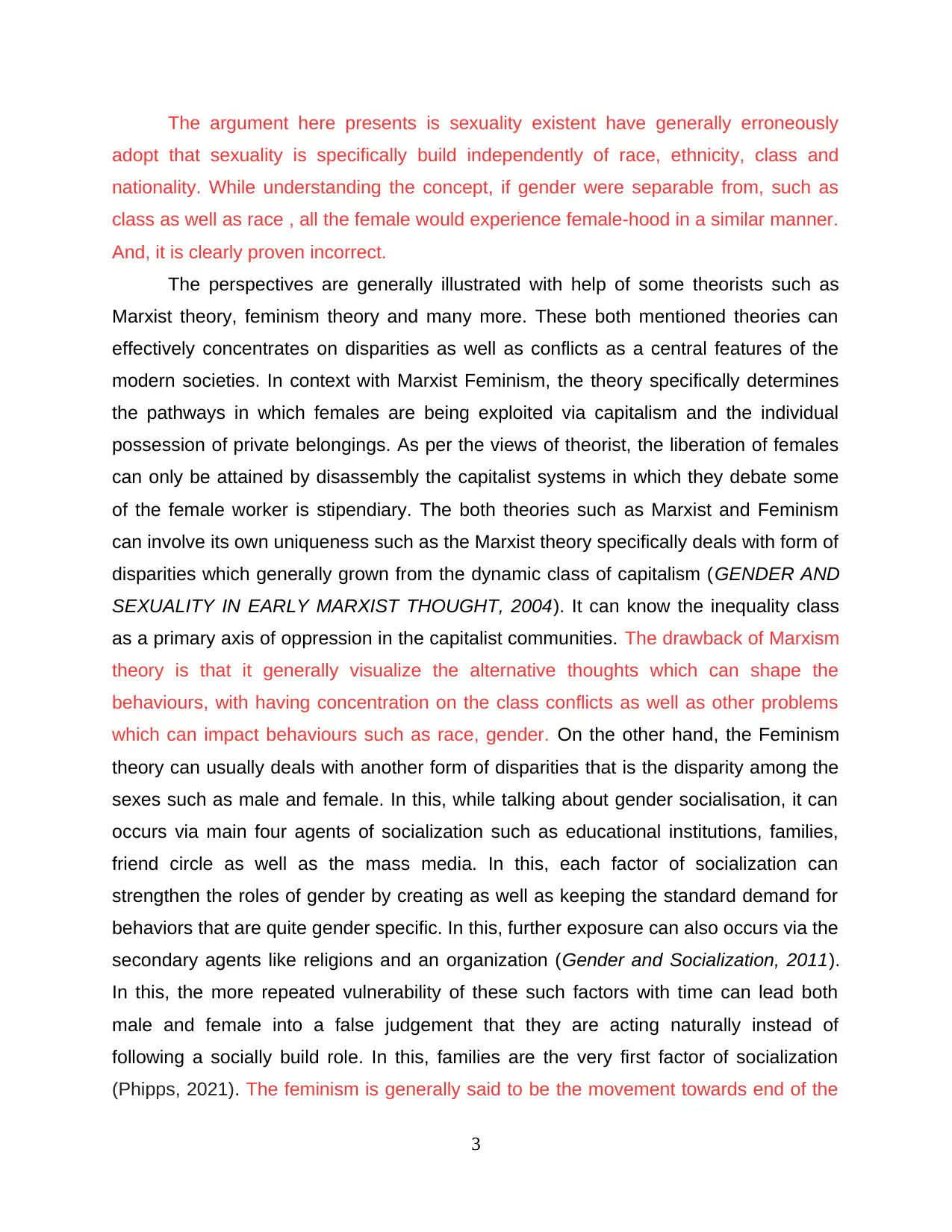
The argument here presents is sexuality existent have generally erroneously
adopt that sexuality is specifically build independently of race, ethnicity, class and
nationality. While understanding the concept, if gender were separable from, such as
class as well as race , all the female would experience female-hood in a similar manner.
And, it is clearly proven incorrect.
The perspectives are generally illustrated with help of some theorists such as
Marxist theory, feminism theory and many more. These both mentioned theories can
effectively concentrates on disparities as well as conflicts as a central features of the
modern societies. In context with Marxist Feminism, the theory specifically determines
the pathways in which females are being exploited via capitalism and the individual
possession of private belongings. As per the views of theorist, the liberation of females
can only be attained by disassembly the capitalist systems in which they debate some
of the female worker is stipendiary. The both theories such as Marxist and Feminism
can involve its own uniqueness such as the Marxist theory specifically deals with form of
disparities which generally grown from the dynamic class of capitalism (GENDER AND
SEXUALITY IN EARLY MARXIST THOUGHT, 2004). It can know the inequality class
as a primary axis of oppression in the capitalist communities. The drawback of Marxism
theory is that it generally visualize the alternative thoughts which can shape the
behaviours, with having concentration on the class conflicts as well as other problems
which can impact behaviours such as race, gender. On the other hand, the Feminism
theory can usually deals with another form of disparities that is the disparity among the
sexes such as male and female. In this, while talking about gender socialisation, it can
occurs via main four agents of socialization such as educational institutions, families,
friend circle as well as the mass media. In this, each factor of socialization can
strengthen the roles of gender by creating as well as keeping the standard demand for
behaviors that are quite gender specific. In this, further exposure can also occurs via the
secondary agents like religions and an organization (Gender and Socialization, 2011).
In this, the more repeated vulnerability of these such factors with time can lead both
male and female into a false judgement that they are acting naturally instead of
following a socially build role. In this, families are the very first factor of socialization
(Phipps, 2021). The feminism is generally said to be the movement towards end of the
3
adopt that sexuality is specifically build independently of race, ethnicity, class and
nationality. While understanding the concept, if gender were separable from, such as
class as well as race , all the female would experience female-hood in a similar manner.
And, it is clearly proven incorrect.
The perspectives are generally illustrated with help of some theorists such as
Marxist theory, feminism theory and many more. These both mentioned theories can
effectively concentrates on disparities as well as conflicts as a central features of the
modern societies. In context with Marxist Feminism, the theory specifically determines
the pathways in which females are being exploited via capitalism and the individual
possession of private belongings. As per the views of theorist, the liberation of females
can only be attained by disassembly the capitalist systems in which they debate some
of the female worker is stipendiary. The both theories such as Marxist and Feminism
can involve its own uniqueness such as the Marxist theory specifically deals with form of
disparities which generally grown from the dynamic class of capitalism (GENDER AND
SEXUALITY IN EARLY MARXIST THOUGHT, 2004). It can know the inequality class
as a primary axis of oppression in the capitalist communities. The drawback of Marxism
theory is that it generally visualize the alternative thoughts which can shape the
behaviours, with having concentration on the class conflicts as well as other problems
which can impact behaviours such as race, gender. On the other hand, the Feminism
theory can usually deals with another form of disparities that is the disparity among the
sexes such as male and female. In this, while talking about gender socialisation, it can
occurs via main four agents of socialization such as educational institutions, families,
friend circle as well as the mass media. In this, each factor of socialization can
strengthen the roles of gender by creating as well as keeping the standard demand for
behaviors that are quite gender specific. In this, further exposure can also occurs via the
secondary agents like religions and an organization (Gender and Socialization, 2011).
In this, the more repeated vulnerability of these such factors with time can lead both
male and female into a false judgement that they are acting naturally instead of
following a socially build role. In this, families are the very first factor of socialization
(Phipps, 2021). The feminism is generally said to be the movement towards end of the
3
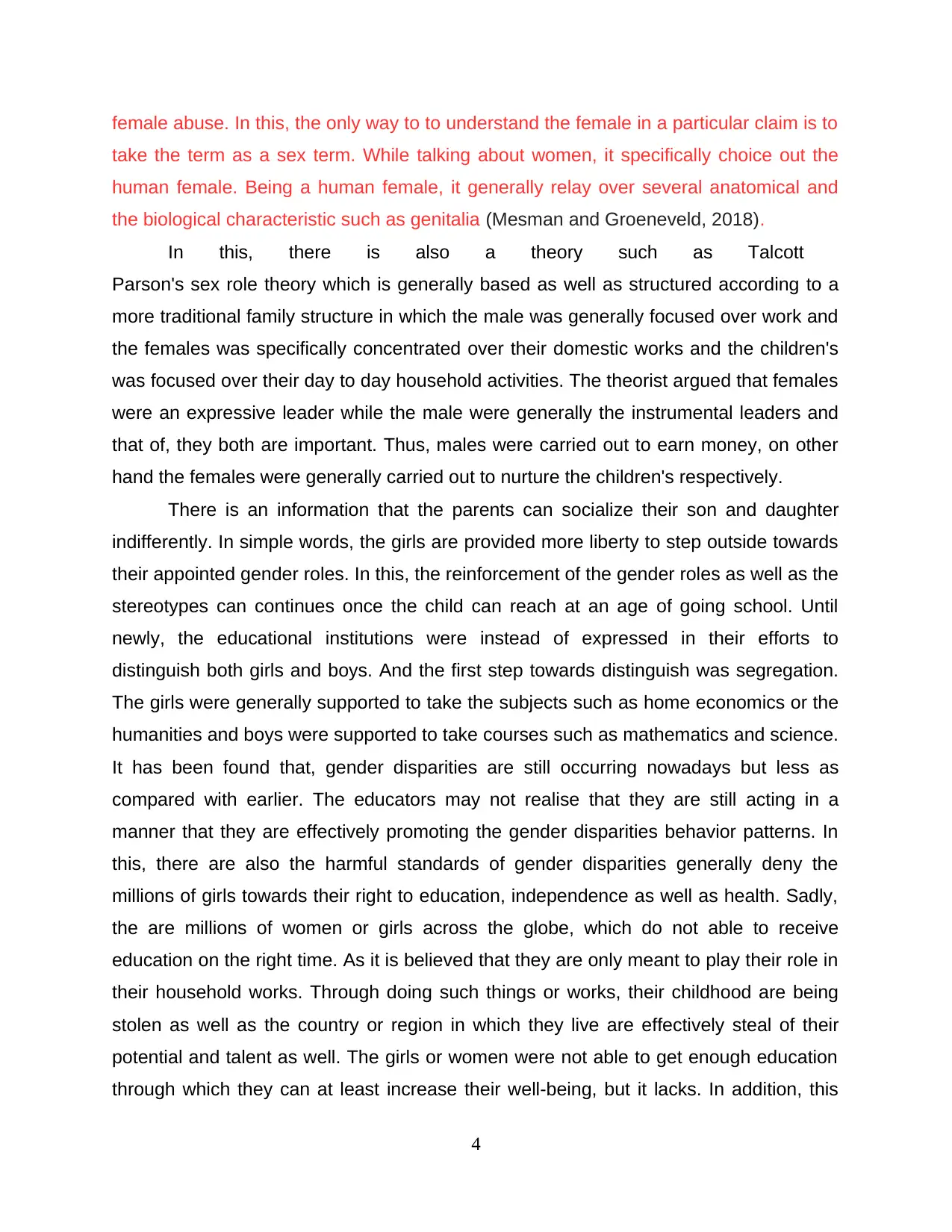
female abuse. In this, the only way to to understand the female in a particular claim is to
take the term as a sex term. While talking about women, it specifically choice out the
human female. Being a human female, it generally relay over several anatomical and
the biological characteristic such as genitalia (Mesman and Groeneveld, 2018).
In this, there is also a theory such as Talcott
Parson's sex role theory which is generally based as well as structured according to a
more traditional family structure in which the male was generally focused over work and
the females was specifically concentrated over their domestic works and the children's
was focused over their day to day household activities. The theorist argued that females
were an expressive leader while the male were generally the instrumental leaders and
that of, they both are important. Thus, males were carried out to earn money, on other
hand the females were generally carried out to nurture the children's respectively.
There is an information that the parents can socialize their son and daughter
indifferently. In simple words, the girls are provided more liberty to step outside towards
their appointed gender roles. In this, the reinforcement of the gender roles as well as the
stereotypes can continues once the child can reach at an age of going school. Until
newly, the educational institutions were instead of expressed in their efforts to
distinguish both girls and boys. And the first step towards distinguish was segregation.
The girls were generally supported to take the subjects such as home economics or the
humanities and boys were supported to take courses such as mathematics and science.
It has been found that, gender disparities are still occurring nowadays but less as
compared with earlier. The educators may not realise that they are still acting in a
manner that they are effectively promoting the gender disparities behavior patterns. In
this, there are also the harmful standards of gender disparities generally deny the
millions of girls towards their right to education, independence as well as health. Sadly,
the are millions of women or girls across the globe, which do not able to receive
education on the right time. As it is believed that they are only meant to play their role in
their household works. Through doing such things or works, their childhood are being
stolen as well as the country or region in which they live are effectively steal of their
potential and talent as well. The girls or women were not able to get enough education
through which they can at least increase their well-being, but it lacks. In addition, this
4
take the term as a sex term. While talking about women, it specifically choice out the
human female. Being a human female, it generally relay over several anatomical and
the biological characteristic such as genitalia (Mesman and Groeneveld, 2018).
In this, there is also a theory such as Talcott
Parson's sex role theory which is generally based as well as structured according to a
more traditional family structure in which the male was generally focused over work and
the females was specifically concentrated over their domestic works and the children's
was focused over their day to day household activities. The theorist argued that females
were an expressive leader while the male were generally the instrumental leaders and
that of, they both are important. Thus, males were carried out to earn money, on other
hand the females were generally carried out to nurture the children's respectively.
There is an information that the parents can socialize their son and daughter
indifferently. In simple words, the girls are provided more liberty to step outside towards
their appointed gender roles. In this, the reinforcement of the gender roles as well as the
stereotypes can continues once the child can reach at an age of going school. Until
newly, the educational institutions were instead of expressed in their efforts to
distinguish both girls and boys. And the first step towards distinguish was segregation.
The girls were generally supported to take the subjects such as home economics or the
humanities and boys were supported to take courses such as mathematics and science.
It has been found that, gender disparities are still occurring nowadays but less as
compared with earlier. The educators may not realise that they are still acting in a
manner that they are effectively promoting the gender disparities behavior patterns. In
this, there are also the harmful standards of gender disparities generally deny the
millions of girls towards their right to education, independence as well as health. Sadly,
the are millions of women or girls across the globe, which do not able to receive
education on the right time. As it is believed that they are only meant to play their role in
their household works. Through doing such things or works, their childhood are being
stolen as well as the country or region in which they live are effectively steal of their
potential and talent as well. The girls or women were not able to get enough education
through which they can at least increase their well-being, but it lacks. In addition, this
4
⊘ This is a preview!⊘
Do you want full access?
Subscribe today to unlock all pages.

Trusted by 1+ million students worldwide
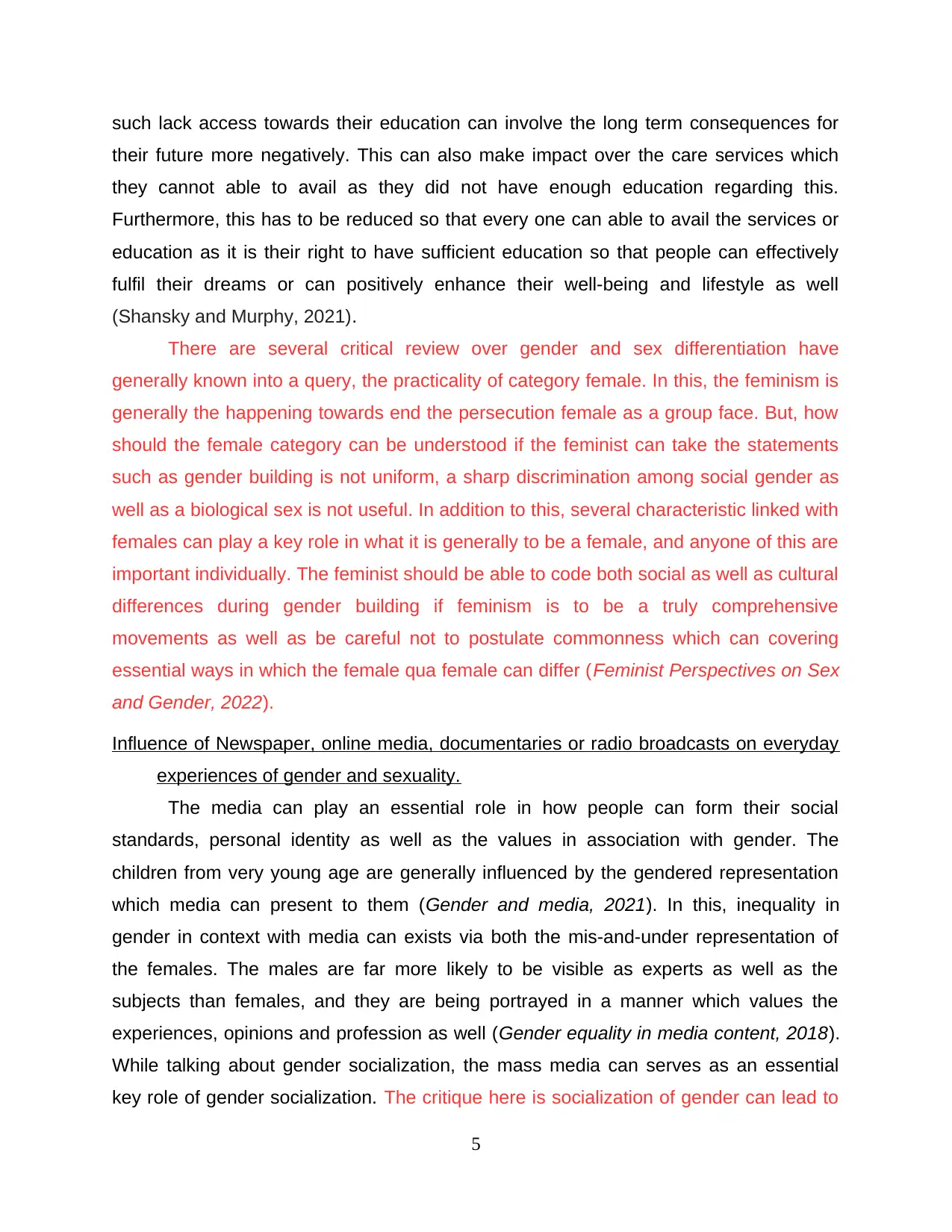
such lack access towards their education can involve the long term consequences for
their future more negatively. This can also make impact over the care services which
they cannot able to avail as they did not have enough education regarding this.
Furthermore, this has to be reduced so that every one can able to avail the services or
education as it is their right to have sufficient education so that people can effectively
fulfil their dreams or can positively enhance their well-being and lifestyle as well
(Shansky and Murphy, 2021).
There are several critical review over gender and sex differentiation have
generally known into a query, the practicality of category female. In this, the feminism is
generally the happening towards end the persecution female as a group face. But, how
should the female category can be understood if the feminist can take the statements
such as gender building is not uniform, a sharp discrimination among social gender as
well as a biological sex is not useful. In addition to this, several characteristic linked with
females can play a key role in what it is generally to be a female, and anyone of this are
important individually. The feminist should be able to code both social as well as cultural
differences during gender building if feminism is to be a truly comprehensive
movements as well as be careful not to postulate commonness which can covering
essential ways in which the female qua female can differ (Feminist Perspectives on Sex
and Gender, 2022).
Influence of Newspaper, online media, documentaries or radio broadcasts on everyday
experiences of gender and sexuality.
The media can play an essential role in how people can form their social
standards, personal identity as well as the values in association with gender. The
children from very young age are generally influenced by the gendered representation
which media can present to them (Gender and media, 2021). In this, inequality in
gender in context with media can exists via both the mis-and-under representation of
the females. The males are far more likely to be visible as experts as well as the
subjects than females, and they are being portrayed in a manner which values the
experiences, opinions and profession as well (Gender equality in media content, 2018).
While talking about gender socialization, the mass media can serves as an essential
key role of gender socialization. The critique here is socialization of gender can lead to
5
their future more negatively. This can also make impact over the care services which
they cannot able to avail as they did not have enough education regarding this.
Furthermore, this has to be reduced so that every one can able to avail the services or
education as it is their right to have sufficient education so that people can effectively
fulfil their dreams or can positively enhance their well-being and lifestyle as well
(Shansky and Murphy, 2021).
There are several critical review over gender and sex differentiation have
generally known into a query, the practicality of category female. In this, the feminism is
generally the happening towards end the persecution female as a group face. But, how
should the female category can be understood if the feminist can take the statements
such as gender building is not uniform, a sharp discrimination among social gender as
well as a biological sex is not useful. In addition to this, several characteristic linked with
females can play a key role in what it is generally to be a female, and anyone of this are
important individually. The feminist should be able to code both social as well as cultural
differences during gender building if feminism is to be a truly comprehensive
movements as well as be careful not to postulate commonness which can covering
essential ways in which the female qua female can differ (Feminist Perspectives on Sex
and Gender, 2022).
Influence of Newspaper, online media, documentaries or radio broadcasts on everyday
experiences of gender and sexuality.
The media can play an essential role in how people can form their social
standards, personal identity as well as the values in association with gender. The
children from very young age are generally influenced by the gendered representation
which media can present to them (Gender and media, 2021). In this, inequality in
gender in context with media can exists via both the mis-and-under representation of
the females. The males are far more likely to be visible as experts as well as the
subjects than females, and they are being portrayed in a manner which values the
experiences, opinions and profession as well (Gender equality in media content, 2018).
While talking about gender socialization, the mass media can serves as an essential
key role of gender socialization. The critique here is socialization of gender can lead to
5
Paraphrase This Document
Need a fresh take? Get an instant paraphrase of this document with our AI Paraphraser
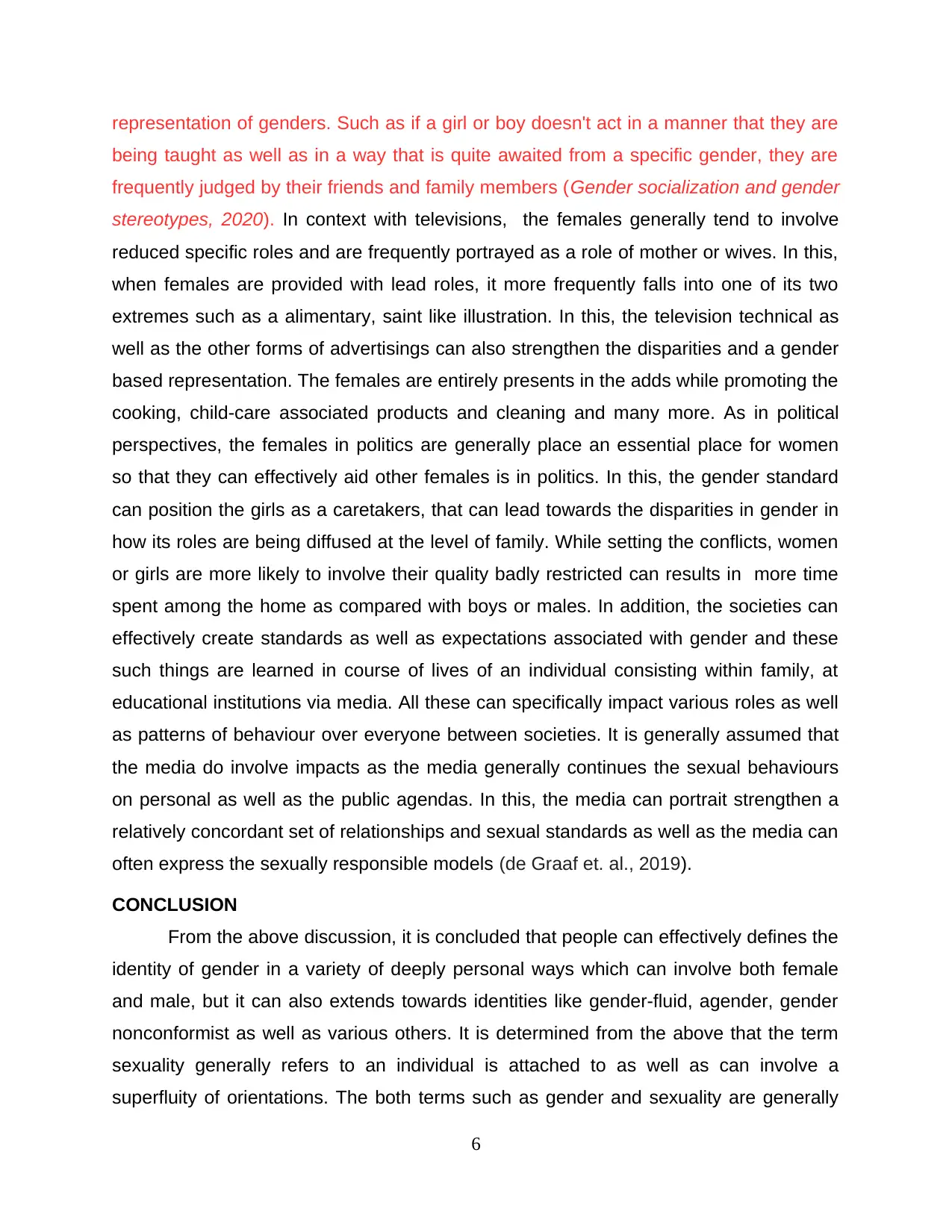
representation of genders. Such as if a girl or boy doesn't act in a manner that they are
being taught as well as in a way that is quite awaited from a specific gender, they are
frequently judged by their friends and family members (Gender socialization and gender
stereotypes, 2020). In context with televisions, the females generally tend to involve
reduced specific roles and are frequently portrayed as a role of mother or wives. In this,
when females are provided with lead roles, it more frequently falls into one of its two
extremes such as a alimentary, saint like illustration. In this, the television technical as
well as the other forms of advertisings can also strengthen the disparities and a gender
based representation. The females are entirely presents in the adds while promoting the
cooking, child-care associated products and cleaning and many more. As in political
perspectives, the females in politics are generally place an essential place for women
so that they can effectively aid other females is in politics. In this, the gender standard
can position the girls as a caretakers, that can lead towards the disparities in gender in
how its roles are being diffused at the level of family. While setting the conflicts, women
or girls are more likely to involve their quality badly restricted can results in more time
spent among the home as compared with boys or males. In addition, the societies can
effectively create standards as well as expectations associated with gender and these
such things are learned in course of lives of an individual consisting within family, at
educational institutions via media. All these can specifically impact various roles as well
as patterns of behaviour over everyone between societies. It is generally assumed that
the media do involve impacts as the media generally continues the sexual behaviours
on personal as well as the public agendas. In this, the media can portrait strengthen a
relatively concordant set of relationships and sexual standards as well as the media can
often express the sexually responsible models (de Graaf et. al., 2019).
CONCLUSION
From the above discussion, it is concluded that people can effectively defines the
identity of gender in a variety of deeply personal ways which can involve both female
and male, but it can also extends towards identities like gender-fluid, agender, gender
nonconformist as well as various others. It is determined from the above that the term
sexuality generally refers to an individual is attached to as well as can involve a
superfluity of orientations. The both terms such as gender and sexuality are generally
6
being taught as well as in a way that is quite awaited from a specific gender, they are
frequently judged by their friends and family members (Gender socialization and gender
stereotypes, 2020). In context with televisions, the females generally tend to involve
reduced specific roles and are frequently portrayed as a role of mother or wives. In this,
when females are provided with lead roles, it more frequently falls into one of its two
extremes such as a alimentary, saint like illustration. In this, the television technical as
well as the other forms of advertisings can also strengthen the disparities and a gender
based representation. The females are entirely presents in the adds while promoting the
cooking, child-care associated products and cleaning and many more. As in political
perspectives, the females in politics are generally place an essential place for women
so that they can effectively aid other females is in politics. In this, the gender standard
can position the girls as a caretakers, that can lead towards the disparities in gender in
how its roles are being diffused at the level of family. While setting the conflicts, women
or girls are more likely to involve their quality badly restricted can results in more time
spent among the home as compared with boys or males. In addition, the societies can
effectively create standards as well as expectations associated with gender and these
such things are learned in course of lives of an individual consisting within family, at
educational institutions via media. All these can specifically impact various roles as well
as patterns of behaviour over everyone between societies. It is generally assumed that
the media do involve impacts as the media generally continues the sexual behaviours
on personal as well as the public agendas. In this, the media can portrait strengthen a
relatively concordant set of relationships and sexual standards as well as the media can
often express the sexually responsible models (de Graaf et. al., 2019).
CONCLUSION
From the above discussion, it is concluded that people can effectively defines the
identity of gender in a variety of deeply personal ways which can involve both female
and male, but it can also extends towards identities like gender-fluid, agender, gender
nonconformist as well as various others. It is determined from the above that the term
sexuality generally refers to an individual is attached to as well as can involve a
superfluity of orientations. The both terms such as gender and sexuality are generally
6
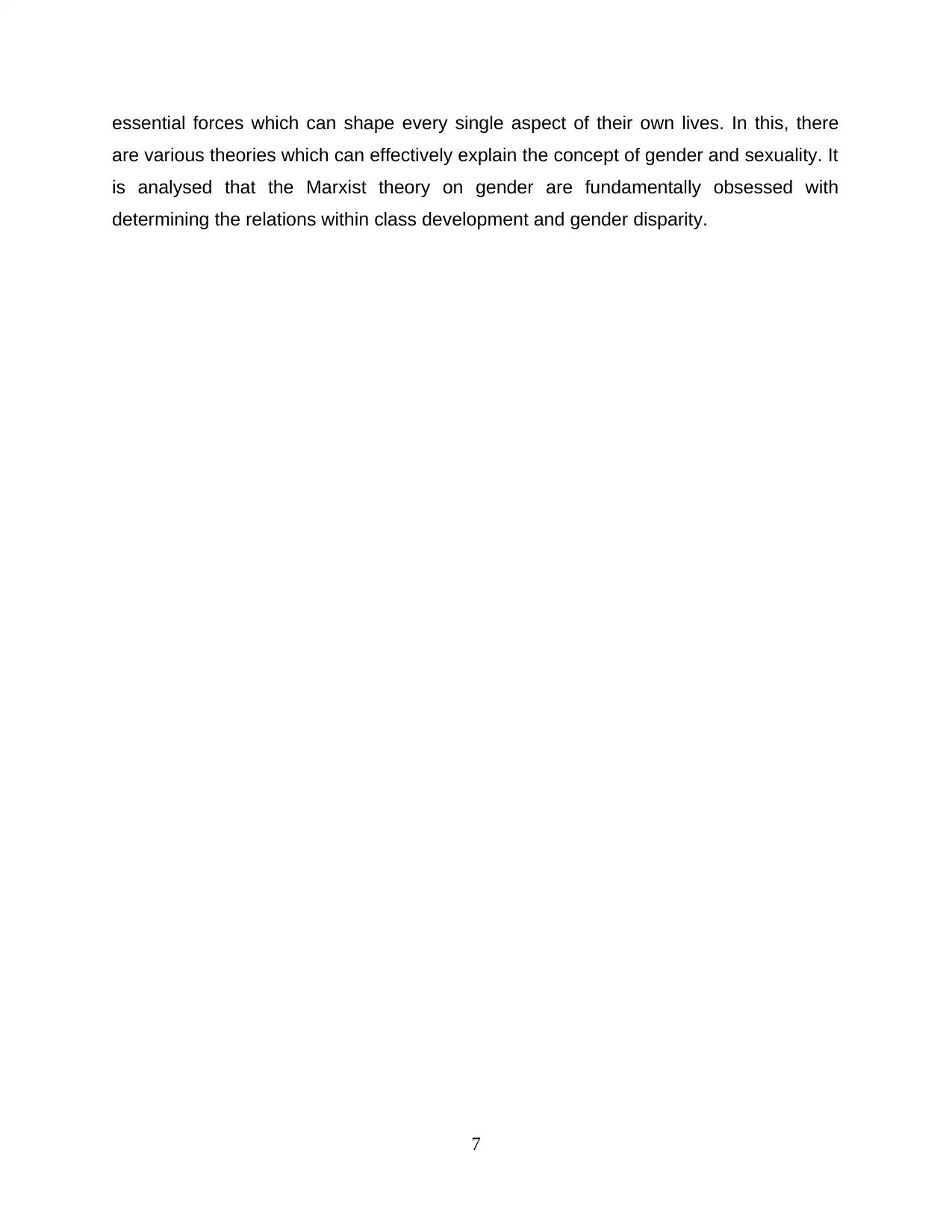
essential forces which can shape every single aspect of their own lives. In this, there
are various theories which can effectively explain the concept of gender and sexuality. It
is analysed that the Marxist theory on gender are fundamentally obsessed with
determining the relations within class development and gender disparity.
7
are various theories which can effectively explain the concept of gender and sexuality. It
is analysed that the Marxist theory on gender are fundamentally obsessed with
determining the relations within class development and gender disparity.
7
⊘ This is a preview!⊘
Do you want full access?
Subscribe today to unlock all pages.

Trusted by 1+ million students worldwide
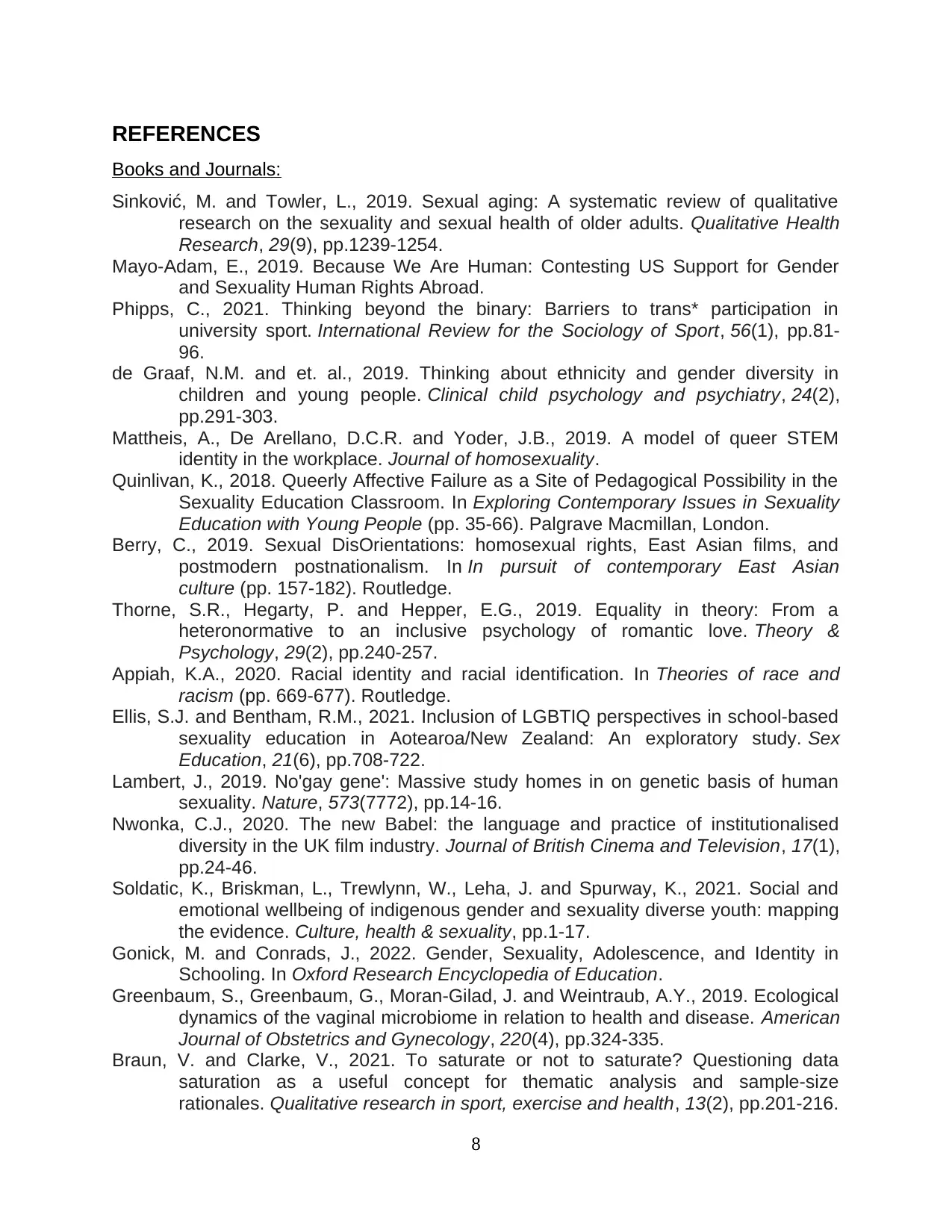
REFERENCES
Books and Journals:
Sinković, M. and Towler, L., 2019. Sexual aging: A systematic review of qualitative
research on the sexuality and sexual health of older adults. Qualitative Health
Research, 29(9), pp.1239-1254.
Mayo-Adam, E., 2019. Because We Are Human: Contesting US Support for Gender
and Sexuality Human Rights Abroad.
Phipps, C., 2021. Thinking beyond the binary: Barriers to trans* participation in
university sport. International Review for the Sociology of Sport, 56(1), pp.81-
96.
de Graaf, N.M. and et. al., 2019. Thinking about ethnicity and gender diversity in
children and young people. Clinical child psychology and psychiatry, 24(2),
pp.291-303.
Mattheis, A., De Arellano, D.C.R. and Yoder, J.B., 2019. A model of queer STEM
identity in the workplace. Journal of homosexuality.
Quinlivan, K., 2018. Queerly Affective Failure as a Site of Pedagogical Possibility in the
Sexuality Education Classroom. In Exploring Contemporary Issues in Sexuality
Education with Young People (pp. 35-66). Palgrave Macmillan, London.
Berry, C., 2019. Sexual DisOrientations: homosexual rights, East Asian films, and
postmodern postnationalism. In In pursuit of contemporary East Asian
culture (pp. 157-182). Routledge.
Thorne, S.R., Hegarty, P. and Hepper, E.G., 2019. Equality in theory: From a
heteronormative to an inclusive psychology of romantic love. Theory &
Psychology, 29(2), pp.240-257.
Appiah, K.A., 2020. Racial identity and racial identification. In Theories of race and
racism (pp. 669-677). Routledge.
Ellis, S.J. and Bentham, R.M., 2021. Inclusion of LGBTIQ perspectives in school-based
sexuality education in Aotearoa/New Zealand: An exploratory study. Sex
Education, 21(6), pp.708-722.
Lambert, J., 2019. No'gay gene': Massive study homes in on genetic basis of human
sexuality. Nature, 573(7772), pp.14-16.
Nwonka, C.J., 2020. The new Babel: the language and practice of institutionalised
diversity in the UK film industry. Journal of British Cinema and Television, 17(1),
pp.24-46.
Soldatic, K., Briskman, L., Trewlynn, W., Leha, J. and Spurway, K., 2021. Social and
emotional wellbeing of indigenous gender and sexuality diverse youth: mapping
the evidence. Culture, health & sexuality, pp.1-17.
Gonick, M. and Conrads, J., 2022. Gender, Sexuality, Adolescence, and Identity in
Schooling. In Oxford Research Encyclopedia of Education.
Greenbaum, S., Greenbaum, G., Moran-Gilad, J. and Weintraub, A.Y., 2019. Ecological
dynamics of the vaginal microbiome in relation to health and disease. American
Journal of Obstetrics and Gynecology, 220(4), pp.324-335.
Braun, V. and Clarke, V., 2021. To saturate or not to saturate? Questioning data
saturation as a useful concept for thematic analysis and sample-size
rationales. Qualitative research in sport, exercise and health, 13(2), pp.201-216.
8
Books and Journals:
Sinković, M. and Towler, L., 2019. Sexual aging: A systematic review of qualitative
research on the sexuality and sexual health of older adults. Qualitative Health
Research, 29(9), pp.1239-1254.
Mayo-Adam, E., 2019. Because We Are Human: Contesting US Support for Gender
and Sexuality Human Rights Abroad.
Phipps, C., 2021. Thinking beyond the binary: Barriers to trans* participation in
university sport. International Review for the Sociology of Sport, 56(1), pp.81-
96.
de Graaf, N.M. and et. al., 2019. Thinking about ethnicity and gender diversity in
children and young people. Clinical child psychology and psychiatry, 24(2),
pp.291-303.
Mattheis, A., De Arellano, D.C.R. and Yoder, J.B., 2019. A model of queer STEM
identity in the workplace. Journal of homosexuality.
Quinlivan, K., 2018. Queerly Affective Failure as a Site of Pedagogical Possibility in the
Sexuality Education Classroom. In Exploring Contemporary Issues in Sexuality
Education with Young People (pp. 35-66). Palgrave Macmillan, London.
Berry, C., 2019. Sexual DisOrientations: homosexual rights, East Asian films, and
postmodern postnationalism. In In pursuit of contemporary East Asian
culture (pp. 157-182). Routledge.
Thorne, S.R., Hegarty, P. and Hepper, E.G., 2019. Equality in theory: From a
heteronormative to an inclusive psychology of romantic love. Theory &
Psychology, 29(2), pp.240-257.
Appiah, K.A., 2020. Racial identity and racial identification. In Theories of race and
racism (pp. 669-677). Routledge.
Ellis, S.J. and Bentham, R.M., 2021. Inclusion of LGBTIQ perspectives in school-based
sexuality education in Aotearoa/New Zealand: An exploratory study. Sex
Education, 21(6), pp.708-722.
Lambert, J., 2019. No'gay gene': Massive study homes in on genetic basis of human
sexuality. Nature, 573(7772), pp.14-16.
Nwonka, C.J., 2020. The new Babel: the language and practice of institutionalised
diversity in the UK film industry. Journal of British Cinema and Television, 17(1),
pp.24-46.
Soldatic, K., Briskman, L., Trewlynn, W., Leha, J. and Spurway, K., 2021. Social and
emotional wellbeing of indigenous gender and sexuality diverse youth: mapping
the evidence. Culture, health & sexuality, pp.1-17.
Gonick, M. and Conrads, J., 2022. Gender, Sexuality, Adolescence, and Identity in
Schooling. In Oxford Research Encyclopedia of Education.
Greenbaum, S., Greenbaum, G., Moran-Gilad, J. and Weintraub, A.Y., 2019. Ecological
dynamics of the vaginal microbiome in relation to health and disease. American
Journal of Obstetrics and Gynecology, 220(4), pp.324-335.
Braun, V. and Clarke, V., 2021. To saturate or not to saturate? Questioning data
saturation as a useful concept for thematic analysis and sample-size
rationales. Qualitative research in sport, exercise and health, 13(2), pp.201-216.
8
Paraphrase This Document
Need a fresh take? Get an instant paraphrase of this document with our AI Paraphraser
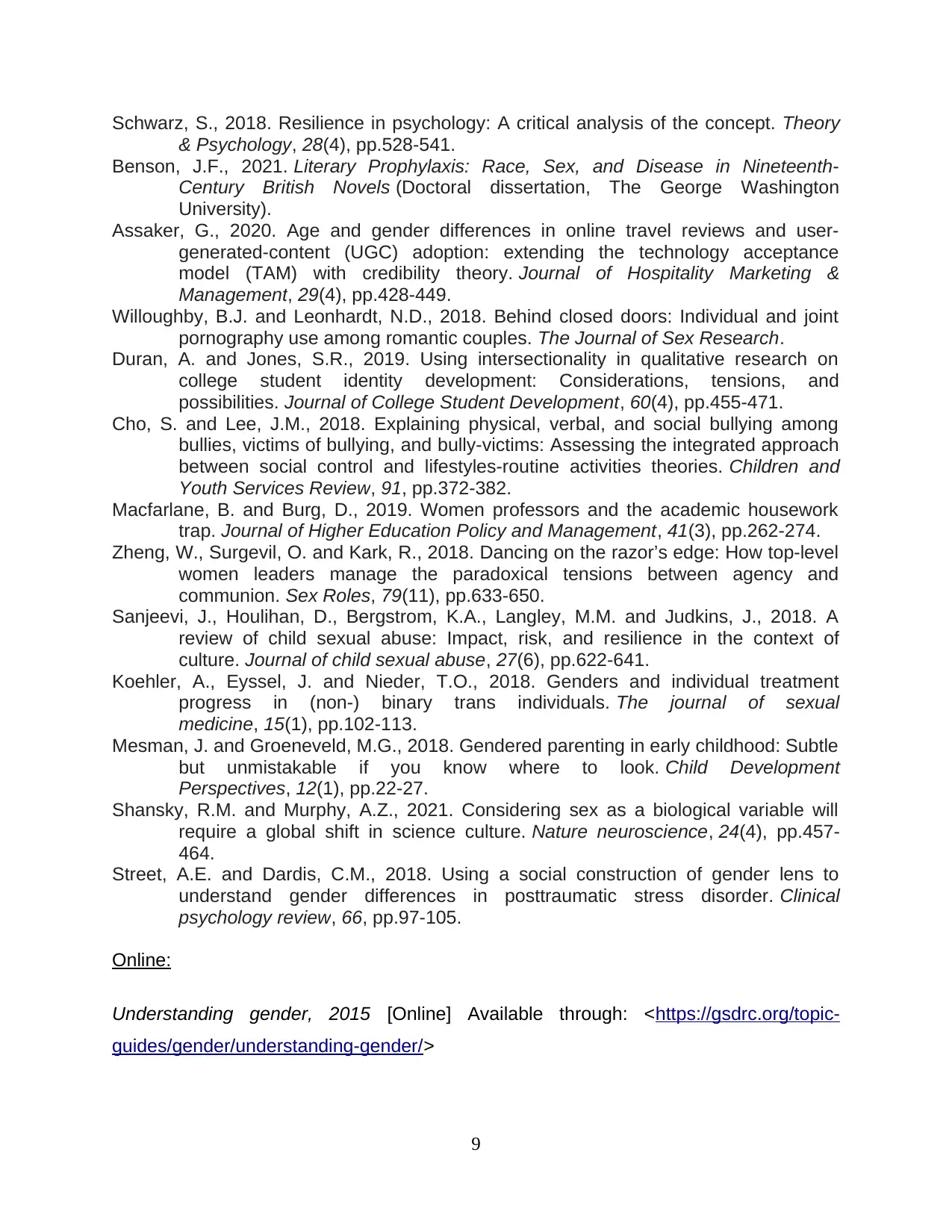
Schwarz, S., 2018. Resilience in psychology: A critical analysis of the concept. Theory
& Psychology, 28(4), pp.528-541.
Benson, J.F., 2021. Literary Prophylaxis: Race, Sex, and Disease in Nineteenth-
Century British Novels (Doctoral dissertation, The George Washington
University).
Assaker, G., 2020. Age and gender differences in online travel reviews and user-
generated-content (UGC) adoption: extending the technology acceptance
model (TAM) with credibility theory. Journal of Hospitality Marketing &
Management, 29(4), pp.428-449.
Willoughby, B.J. and Leonhardt, N.D., 2018. Behind closed doors: Individual and joint
pornography use among romantic couples. The Journal of Sex Research.
Duran, A. and Jones, S.R., 2019. Using intersectionality in qualitative research on
college student identity development: Considerations, tensions, and
possibilities. Journal of College Student Development, 60(4), pp.455-471.
Cho, S. and Lee, J.M., 2018. Explaining physical, verbal, and social bullying among
bullies, victims of bullying, and bully-victims: Assessing the integrated approach
between social control and lifestyles-routine activities theories. Children and
Youth Services Review, 91, pp.372-382.
Macfarlane, B. and Burg, D., 2019. Women professors and the academic housework
trap. Journal of Higher Education Policy and Management, 41(3), pp.262-274.
Zheng, W., Surgevil, O. and Kark, R., 2018. Dancing on the razor’s edge: How top-level
women leaders manage the paradoxical tensions between agency and
communion. Sex Roles, 79(11), pp.633-650.
Sanjeevi, J., Houlihan, D., Bergstrom, K.A., Langley, M.M. and Judkins, J., 2018. A
review of child sexual abuse: Impact, risk, and resilience in the context of
culture. Journal of child sexual abuse, 27(6), pp.622-641.
Koehler, A., Eyssel, J. and Nieder, T.O., 2018. Genders and individual treatment
progress in (non-) binary trans individuals. The journal of sexual
medicine, 15(1), pp.102-113.
Mesman, J. and Groeneveld, M.G., 2018. Gendered parenting in early childhood: Subtle
but unmistakable if you know where to look. Child Development
Perspectives, 12(1), pp.22-27.
Shansky, R.M. and Murphy, A.Z., 2021. Considering sex as a biological variable will
require a global shift in science culture. Nature neuroscience, 24(4), pp.457-
464.
Street, A.E. and Dardis, C.M., 2018. Using a social construction of gender lens to
understand gender differences in posttraumatic stress disorder. Clinical
psychology review, 66, pp.97-105.
Online:
Understanding gender, 2015 [Online] Available through: <https://gsdrc.org/topic-
guides/gender/understanding-gender/>
9
& Psychology, 28(4), pp.528-541.
Benson, J.F., 2021. Literary Prophylaxis: Race, Sex, and Disease in Nineteenth-
Century British Novels (Doctoral dissertation, The George Washington
University).
Assaker, G., 2020. Age and gender differences in online travel reviews and user-
generated-content (UGC) adoption: extending the technology acceptance
model (TAM) with credibility theory. Journal of Hospitality Marketing &
Management, 29(4), pp.428-449.
Willoughby, B.J. and Leonhardt, N.D., 2018. Behind closed doors: Individual and joint
pornography use among romantic couples. The Journal of Sex Research.
Duran, A. and Jones, S.R., 2019. Using intersectionality in qualitative research on
college student identity development: Considerations, tensions, and
possibilities. Journal of College Student Development, 60(4), pp.455-471.
Cho, S. and Lee, J.M., 2018. Explaining physical, verbal, and social bullying among
bullies, victims of bullying, and bully-victims: Assessing the integrated approach
between social control and lifestyles-routine activities theories. Children and
Youth Services Review, 91, pp.372-382.
Macfarlane, B. and Burg, D., 2019. Women professors and the academic housework
trap. Journal of Higher Education Policy and Management, 41(3), pp.262-274.
Zheng, W., Surgevil, O. and Kark, R., 2018. Dancing on the razor’s edge: How top-level
women leaders manage the paradoxical tensions between agency and
communion. Sex Roles, 79(11), pp.633-650.
Sanjeevi, J., Houlihan, D., Bergstrom, K.A., Langley, M.M. and Judkins, J., 2018. A
review of child sexual abuse: Impact, risk, and resilience in the context of
culture. Journal of child sexual abuse, 27(6), pp.622-641.
Koehler, A., Eyssel, J. and Nieder, T.O., 2018. Genders and individual treatment
progress in (non-) binary trans individuals. The journal of sexual
medicine, 15(1), pp.102-113.
Mesman, J. and Groeneveld, M.G., 2018. Gendered parenting in early childhood: Subtle
but unmistakable if you know where to look. Child Development
Perspectives, 12(1), pp.22-27.
Shansky, R.M. and Murphy, A.Z., 2021. Considering sex as a biological variable will
require a global shift in science culture. Nature neuroscience, 24(4), pp.457-
464.
Street, A.E. and Dardis, C.M., 2018. Using a social construction of gender lens to
understand gender differences in posttraumatic stress disorder. Clinical
psychology review, 66, pp.97-105.
Online:
Understanding gender, 2015 [Online] Available through: <https://gsdrc.org/topic-
guides/gender/understanding-gender/>
9
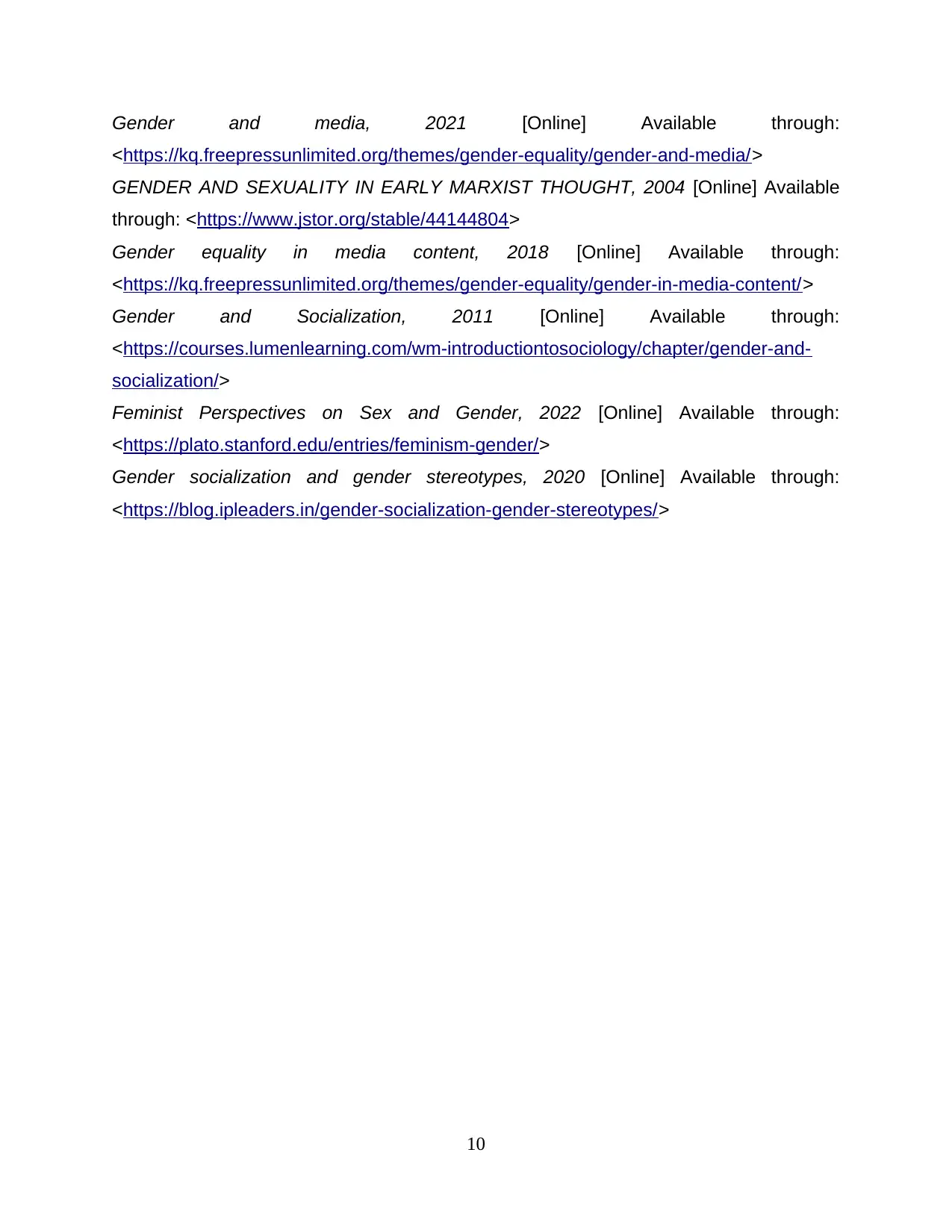
Gender and media, 2021 [Online] Available through:
<https://kq.freepressunlimited.org/themes/gender-equality/gender-and-media/>
GENDER AND SEXUALITY IN EARLY MARXIST THOUGHT, 2004 [Online] Available
through: <https://www.jstor.org/stable/44144804>
Gender equality in media content, 2018 [Online] Available through:
<https://kq.freepressunlimited.org/themes/gender-equality/gender-in-media-content/>
Gender and Socialization, 2011 [Online] Available through:
<https://courses.lumenlearning.com/wm-introductiontosociology/chapter/gender-and-
socialization/>
Feminist Perspectives on Sex and Gender, 2022 [Online] Available through:
<https://plato.stanford.edu/entries/feminism-gender/>
Gender socialization and gender stereotypes, 2020 [Online] Available through:
<https://blog.ipleaders.in/gender-socialization-gender-stereotypes/>
10
<https://kq.freepressunlimited.org/themes/gender-equality/gender-and-media/>
GENDER AND SEXUALITY IN EARLY MARXIST THOUGHT, 2004 [Online] Available
through: <https://www.jstor.org/stable/44144804>
Gender equality in media content, 2018 [Online] Available through:
<https://kq.freepressunlimited.org/themes/gender-equality/gender-in-media-content/>
Gender and Socialization, 2011 [Online] Available through:
<https://courses.lumenlearning.com/wm-introductiontosociology/chapter/gender-and-
socialization/>
Feminist Perspectives on Sex and Gender, 2022 [Online] Available through:
<https://plato.stanford.edu/entries/feminism-gender/>
Gender socialization and gender stereotypes, 2020 [Online] Available through:
<https://blog.ipleaders.in/gender-socialization-gender-stereotypes/>
10
⊘ This is a preview!⊘
Do you want full access?
Subscribe today to unlock all pages.

Trusted by 1+ million students worldwide
1 out of 12
Related Documents
Your All-in-One AI-Powered Toolkit for Academic Success.
+13062052269
info@desklib.com
Available 24*7 on WhatsApp / Email
![[object Object]](/_next/static/media/star-bottom.7253800d.svg)
Unlock your academic potential
Copyright © 2020–2025 A2Z Services. All Rights Reserved. Developed and managed by ZUCOL.




